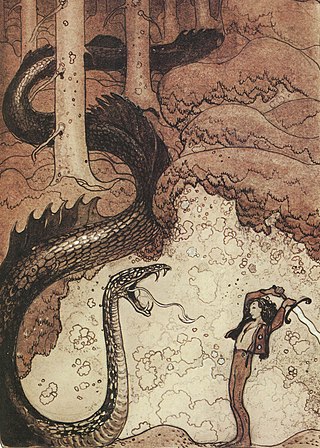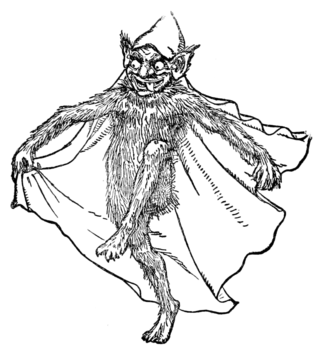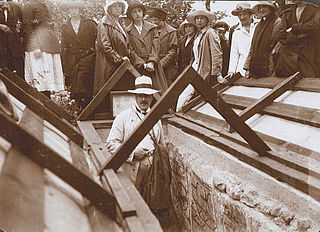Related Research Articles

A nymph is a minor female nature deity in ancient Greek folklore. Distinct from other Greek goddesses, nymphs are generally regarded as personifications of nature; they are typically tied to a specific place, landform, or tree, and are usually depicted as maidens. Because of their association with springs, they were often seen as having healing properties; other divine powers of the nymphs included divination and shapeshifting. Nymphs, like other goddesses, were immortal except for the Hamadryads, whose lives were bound to a specific tree.

Yggdrasil is an immense and central sacred tree in Norse cosmology. Around it exists all else, including the Nine Worlds.

The rowans or mountain-ashes are shrubs or trees in the genus Sorbus of the rose family, Rosaceae. They are native throughout the cool temperate regions of the Northern Hemisphere, with the highest species diversity in the Himalaya, southern Tibet and parts of western China, where numerous apomictic microspecies occur. The name rowan was originally applied to the species Sorbus aucuparia and is also used for other species in the genus Sorbus.

The lindworm, also spelled lindwyrm or lindwurm, is a mythical creature in Northern, Western and Central European folklore that traditionally has the shape of a giant serpent monster living deep in the forest. It can be seen as a sort of dragon.

The Kronoberg Regiment, designations I 11 and I 11/Fo 16, was a Swedish Army infantry regiment that traced its origins back to the 16th century. It was disbanded in 1997. The regiment's soldiers were originally recruited from Kronoberg County, and they were later garrisoned there.

Nils Blommér, born Nils Johan Olsson was a Swedish painter. His middle name is sometimes given as Jakob.

"The Golden Bird" is a fairy tale collected by the Brothers Grimm about the pursuit of a golden bird by a gardener's three sons.
The Enchanted Wreath is a Scandinavian fairy tale, collected in Benjamin Thorpe in his Yule-Tide Stories: A Collection of Scandinavian and North German Popular Tales and Traditions. Andrew Lang adapted a variant of it for The Orange Fairy Book.

"The Water of Life" is a German fairy tale collected by the Brothers Grimm, tale number 97.

The Knights of the Fish is a Spanish fairy tale collected by Fernán Caballero in Cuentos. Oraciones y Adivinas. Andrew Lang included it in The Brown Fairy Book. A translation was published in Golden Rod Fairy Book. Another version of the tale appears in A Book of Enchantments and Curses by Ruth Manning-Sanders.
Prince Hat under the Ground is the Swedish version of an old Scandinavian fairy tale. The Norwegian version is called East of the Sun and West of the Moon.

Gunnar Olof Hyltén-Cavallius (1818–1889) was a Swedish scholar of cultural history, librarian, theatre director, and diplomat.

The sacred tree at Uppsala was a sacred tree located at the Temple at Uppsala, Sweden, in the second half of the 11th century. It is not known what species it was. Older sources have described it as an ash tree, but Frits Läffler have suggested that it was a yew tree.

George Stephens was an English archeologist and philologist, who worked in Scandinavia, especially on interpreting runic inscriptions.

Odin is a widely revered god in Germanic paganism. Norse mythology, the source of most surviving information about him, associates him with wisdom, healing, death, royalty, the gallows, knowledge, war, battle, victory, sorcery, poetry, frenzy, and the runic alphabet, and depicts him as the husband of the goddess Frigg. In wider Germanic mythology and paganism, the god was also known in Old English as Wōden, in Old Saxon as Uuôden, in Old Dutch as Wuodan, in Old Frisian as Wêda, and in Old High German as Wuotan, all ultimately stemming from the Proto-Germanic theonym *Wōðanaz, meaning 'lord of frenzy', or 'leader of the possessed'.
The Elder Mother is an elder-guarding being in English and Scandinavian folklore known by a variety of names, such as the Danish Hyldemoer ("Elder-Mother") and the Lincolnshire names Old Lady and Old Girl.

A goblin is a small, grotesque, monstrous creature that appears in the folklore of multiple European cultures. First attested in stories from the Middle Ages, they are ascribed conflicting abilities, temperaments, and appearances depending on the story and country of origin, ranging from mischievous household spirits to malicious, bestial thieves. They often have magical abilities similar to a fairy or demon, such as the ability to shapeshift.

Carl Wilhelm von Sydow was a Swedish folklore scholar. A professor at Lund University, he was a pioneer of folklore studies in Sweden and contributed to establishing systematic methods in the field.

Trees hold a particular role in Germanic paganism and Germanic mythology, both as individuals and in groups. The central role of trees in Germanic religion is noted in the earliest written reports about the Germanic peoples, with the Roman historian Tacitus stating that Germanic cult practices took place exclusively in groves rather than temples. Scholars consider that reverence for and rites performed at individual trees are derived from the mythological role of the world tree, Yggdrasil; onomastic and some historical evidence also connects individual deities to both groves and individual trees. After Christianisation, trees continue to play a significant role in the folk beliefs of the Germanic peoples.
Sigurd, the King's Son is an Icelandic fairy tale collected and published by author Jón Árnason. It is related to the international cycle of the Animal as Bridegroom or The Search for the Lost Husband, wherein a human princess marries a prince under an animal curse, loses him and has to search for him.
References
Bibliography
- Hyltén-Cavallius, Gunnar Olof (1864). Wärend och wirdarne, ett försök i svensk ethnologi. 2 deler. Vol. 1. Stockholm: P. A. Norstedt & Söner. p. 310.
- Porteous, Alexander (2006). Forest folklore: Mythology and Romance. London: George Allen & Unwin. p. 93. ISBN 978-1-4286-1254-9.
- Rose, Carol (1996). Spirits, fairies, leprechauns, and goblins. ABC-CLIO. p. 22. ISBN 978-0-87436-811-6.
